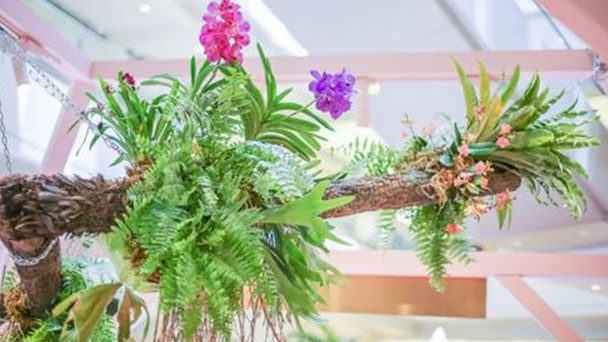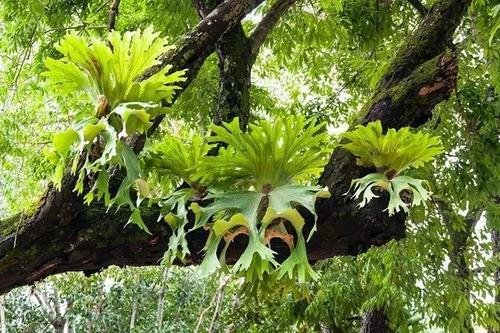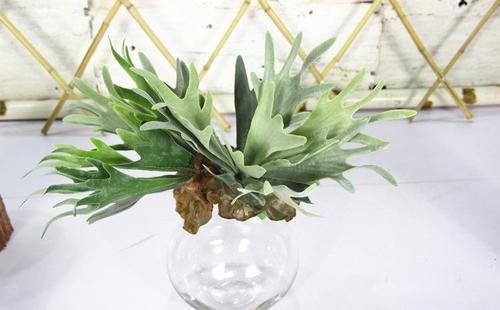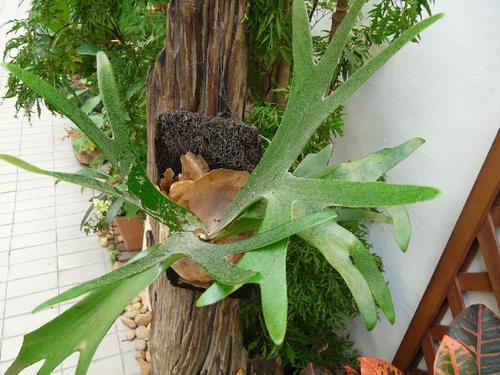Staghorn Fern (Platycerium Wallichii) Profile
Written by Maggie
Nov 09 2021

Staghorn fern (scientific name: Platycerium wallichii Hook.) belongs to the genus Staghorn fern of Polypodiaceae. Staghorn fern is native to tropical regions such as Polynesia in eastern Australia and belongs to the ornamental fern. Its sporophyte is very unique, shaped like a plum deer antler.
Staghorn fern is a perennial epiphytic herbaceous fern with two types of leaves. The basic leaves grow on the trunk of the tree. The leaves can grow for 3-5 times and split irregularly into antler-like branches.
Staghorn fern picture

Staghorn fern info
| Botanical Name | Platycerium bifurcatum |
| Common Names | Staghorn fern, elkhorn fern |
| Plant Type | Fern |
| Sun | Partial shade |
| Hardiness Zones | 9–12 (USDA) |
| Flower color | Non-flowering |
| Native Area | Asia, Australia |
| Mature size | 2–3 ft. tall, 2–3 ft. wide |
Morphological characteristics of Staghorn fern
Staghorn fern is an epiphytic plant with the following main characteristics:
Rhizome is fleshy, short and recumbent, densely scaly; Scales are light brown to grayish white, dark brown middle, hard, linear, 10 mm long and 4 mm wide.
Leaves of Staghorn fern are 2-row, 2-type; Base born sterile leaves (humus) leaves persistent, thick leathery, lower fleshy, 1 cm thick, thin upper, upright, sessile, born in the trunk, 40 centimeters, width nearly equal to, apex cross-sectional shape, not neat, 3-5 times fork crack, lobes nearly isometric, obtuse or pointed end, entire, both sides main veins bulge, veins not obvious, hydrophobic by stellate hairs, early green, soon wither, brown.
Normal fertile leaves of Staghorn fern are usually in pairs, pendulous, grayish green, 25 -- 70 cm long.
Ecological habits of staghorn fern
Staghorn fern likes a warm and humid environment and is afraid of strong light. The scattered light is the best. The temperature in winter is not lower than 5℃, and loose leaf rot soil is the best soil.
The sporophyte and gametophyte all lived independently.
The distribution area of Staghorn fern is tropical monsoon climate, hot and rainy. The annual average temperature is 22.6°C, the average temperature in January is 15-17 °C, the extreme lowest temperature is not less than 5°C, and the extreme highest temperature is 39.5°C. The annual precipitation is about 2000 mm, and the relative humidity is not less than 80%.They are often epiphytic on the trunk and branches of the monsoon rain forest, such as the jacaranda tree and the pendent fig tree, and can also be epiphytic on the trunk of the dead standing tree of the forest margin, sparse forest.
Staghorn Fern feeds on humus leaves that accumulate fallen leaves, dust, and other materials. At the beginning of the rainy season, two new humus leaves and two fertile leaves appeared on the top of the short stem. The humus leaves of the previous year will die and rot in the same year, while the fertile leaves will dry out and shed in the following spring.
How to grow and care for staghorn fern
The moisture
In the Staghorn fern growth season should be watered and often spray water, maintaining higher air humidity. In the summer growth peak period, more water should be watered in the morning or evening when the temperature is low, and often spray water to maintain a higher air humidity in the cultivation environment, which is conducive to the growth and development of vegetative leaves and sporophylls. Winter low temperature, should be watered less to prevent root rot.Watering time as far as possible to arrange in the sunny noon when the temperature is higher.
Fertilization
It can be in the growing period, every ten days spray diluted cake fertilizer water or spray on the leaf surface of the quick-effect dilute urea, keeping the leaf green, hypertrophy. Leaf-rot soil or moss is added to the forming Staghorn Fern basket each year to facilitate the growth and development of new sporophytes. The most afraid of disorderly fertilization, concentrated fertilizer and partial application of nitrogen, phosphorus, potassium fertilizer, the requirement to follow the "light fertilizer frequently applied, the amount of more times, complete nutrition" fertilization (water) principle.
The temperature
The optimum growth temperature is 18℃ ~ 30℃, to avoid cold frost, overwintering temperature needs to be kept above 10℃, in winter the temperature drops below 4℃ into hibernation state. If the ambient temperature is close to 0℃, Staghorn fern will die due to frostbite.
Light
Staghorn Fern is afraid of strong light, avoiding direct light or dry wind. In the outdoor conservation should be placed in the shade or shade shed, at the same time, attention should be paid to the foliar water spraying. Outdoor maintenance can be placed under shade shed, and the sun should be avoided to avoid yellowing and burning of the leaves, which will affect the ornamental value of Staghorn Fern. Every one or two months to move to the outdoor half shade or shade conservation for a month, in order to allow the accumulation of nutrients, restore growth. Read More: How to Grow & Care for Staghorn Fern.

Staghorn Fern propagation
Scatter propagation is often used.
It is best to divide plants in June or July. Select strong Staghorn Fern seed plants from the mother plant, cut them gently along the bottom of the shield-like vegetative leaves with a sharp knife, plant them in the pot with suction roots, cover them with moss, and spray water to moisturize them. Read More: How to propagate Staghorn Fern.
Disease & pest control for staghorn fern
Common leaf spot damage spore leaves of Staghorn fern, can be used 65% of the Zinc WP 600 times spray prevention and control. When ventilation is poor, there are scale insects and whitefly harmful to spore leaves or vegetative leaves, small amounts can be captured or sprayed with 40% oxidized diethoate emulsion 1000 times liquid kill. Some Staghorn Fern are more susceptible to fungal or bacterial diseases. Care should be taken to regulate the ventilation environment and not to overwater.
The distribution area of staghorn fern
Staghorn fern is produced in southwest Yunnan Yingjiang county nabang dam, 210-950 meters above sea level in the mountain rainforest. It is also found in Burma, NE India, Thailand and India.
The breed classification of Staghorn fern
There are more than 16 species of Staghorn Fern in the world. They are mainly wild in the tropical and subtropical rainforests of Africa, Asia, Oceania and South America.They are of high ornamental value, mainly including:
P.Aninum, also known as Andean Staghorn Fern. Originally in Peru, Bolivia.Spore leaf surface is densely covered with fine hairs, white, leaves as long as 3 meters, very spectacular.
P.Angolense, also known as the African Staghorn Fern, is found in Uganda, Zaire and Nigeria. The sporophyllids are large, shaped like ears, and the vegetative leaves are fan-shaped.
E. llisii, Spore leaves grow erect, vegetative leaves renal.
P. Madagascariense, deep fold arched nutrient leaves with obvious veins, like a honeycomb.
P.Stemaria, gray-green throughout, has ascending sporophylls and vegetative leaves, which are oblong and wavy at the top. The sporophyte has two parts, one forked and wedge-shaped, the other smaller and narrower.
P.vassei, vegetative leaves brown, nest shaped with sporangia arranged in a V shape on the dorsum of the leaves.
P. Grande, large vegetative leaves with drooping pale green sporophytes, up to 1.5 m long. It takes 20 years for the mother plant to produce spores.
P. hillii, sporophylls dark green, hard, erect and fan-shaped.
P.veitchii, sporophores covered with white hairs, erect.
P. coronarium, whole plant light green, stellate vegetative leaves 50 cm long and 50 cm wide, pendulous sporophytes up to 4 m long.
P. wilichii, a rare small species with broad, thick, graceful yellowish green sporozoa leaves.
P. wilhelminae-reginae, vegetative leaves coronal, growing upward, 1.5 m high, sporophytes pendulous, 2 m long, is a large species.
P. willinckii, vegetative dark green leaves with silvery pubescent sporophylls, growing downward, 70 cm long, lobed with ribbons. A wide variety of Staghorn Fern provides rich germplasm materials for decorating the interior green space.

Read Next:
Ming Fern (Asparagus Myriocladus) Profile: Care & Growing Guide
Java Fern Care & Growing Guide
Blue Star Fern Care: How to Grow & Care for Phlebodium Aureum
How to Grow & Care for Asparagus Fern
Maidenhair Fern (Adiantum Raddianum) Grow & Care Guide
Birds Nest Fern (Asplenium Nidus) Profile: Info, Care & Growing Guide
How to Grow and Care for Kimberly Queen Fern
Rabbit Foot Fern Care & Propagation Guide
Staghorn Fern (Platycerium Bifurcatum) Care & Growing Guide
Japanese Royal Fern (Osmunda Japonica) Profile
Latest Updated
- Benefits of Bugleweed - 7 Science-backed Health Benefits
- Bugleweed Dangers & Side Effects - Is It Poisonous?
- How to Plant Evergreen Trees - What You Should Know
- When to Plant Evergreens - Grow Guide for Evergreen Trees
- 12 Wonderful Evergreen Shrubs for Your Garden
- 12 Popular Evergreen Plants with Pictures for Beginners
- When And How To Prune A Lilac Bush Like a Pro
- How to Grow & Care for Lilac Vine (Hardenbergia Violacea)
- Japanese Lilac Tree (Syringa Reticulata) Care & Propagation Guide
- Shumard Oak Pros and Cons - What to Know
Popular Articles
- Winter maintenance of Antirrhinum Majus
- How to Grow Terminalia Mantaly Tree
- How to Grow and Care for Crossostephium Chinense
- How to grow Antirrhinum Majus in spring
- Peristeria Elata (Dove Orchid) Profile: Info & Care Guide
- Underwatered Snake Plant (Sansevieria Trifasciata) - Signs And How To Fix
- How to Care for Brazilian Jasmine Plant (Mandevilla Sanderi)
- How to Grow & Care for Graptopetalum Purple Delight in Summer
- Rosa Chinensis (China Rose): Plant Growing & Care Tips
- How to Care for Baby Sun Rose (Aptenia Cordifolia)